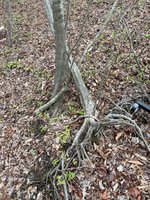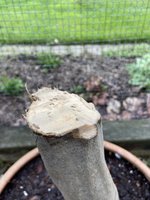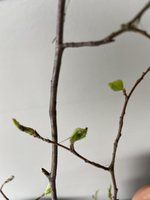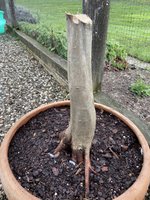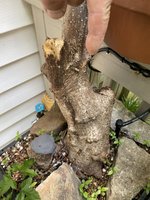So I’m about 2 years into practicing bonsai and I’ve gotten the itch to collect some yamadori specimens. I have the chance to collect somewhere that has a bunch of American hornbeams and wanted to ask for advice. I found one in particular that seems really interesting. It’s a fairly large specimen that fell over at some point and exposed a bunch of large roots. Not sure how I would go about it and just looking for advice. Thanks!
You are using an out of date browser. It may not display this or other websites correctly.
You should upgrade or use an alternative browser.
You should upgrade or use an alternative browser.
American hornbeam collecting advice
- Thread starter pstaboche
- Start date
19Mateo83
Masterpiece
American hornbeams are a pretty resilient tree. They handle root chops pretty well. I have a few that I collected this spring that had very few fine roots and they are now leafed out and growing rather vigorously. Just get as much root as you can and leave the trunk longer than you think you will need. Allow it to bud out this year then next spring trim it closer to where you want it.So I’m about 2 years into practicing bonsai and I’ve gotten the itch to collect some yamadori specimens. I have the chance to collect somewhere that has a bunch of American hornbeams and wanted to ask for advice. I found one in particular that seems really interesting. It’s a fairly large specimen that fell over at some point and exposed a bunch of large roots. Not sure how I would go about it and just looking for advice. Thanks!
Shogun610
Masterpiece
First I’d say , I would pass on this particular tree in question. Secondly the survival rate once it is collected diminishes greatly once the tree in question already starts to leaf out because its already moving sugars and starches to push new leaves , you want to collect earlier before that so there is enough stored energy. You’re in MD so I believe you’re ahead of us in PA. Since you already have the ok to collect in this location. I would tag specimens you wish to harvest next spring for maximum survival rate.
rockm
Spuds Moyogi
Let that one be. That one is Not worth the trouble and will only be a pain to work with. If there's one this sized, you can bet there are more around, most will be alot better.
Look for an upright tree with a base that has some flare.--think base of a volcano-ish. Think 3-6 inches in diameter.American hornbeams close trunk chop wound V-e-r-y s-l-o-w-l-y if at all. It's a problem with the species and bonsai. Huge collected hornbeam almost always have some dead wood carving at the top that takes away from otherwise nice trees.
You dig hornbeam around here beginning in late Feb. just before buds break-the closer you can get to bud extension without actual leaves developing, the better. Mid-March can be prime time, but cold springs can slow things down. When you collect, simply measure out from the main trunk six inches, saw off major roots all around the tree with a hand saw or better yet a cordless reciprocating saw, Explore around the trunk again with a hand trowel or small shovel (shovels are useless in actually digging up a hornbeam.THey make a good prybar however.) Find the deeper thicker roots, use the saw again, push (the still intact) trunk to see if it moves. If it does, see if you can push it hard until the root mass is more exposed--apply the saw. Push and pull and move the trunk using the trunk as a level to do so. That can help break remaining old roots. Eventually with repeated sawing and leveraging, you will probably hear a "pop" and the trunk moves freely. That means you can lift it out and start sawing off root, including the ones you split by leveraging the trunk. Then top the trunk--typically on larger trees I chop the trunk to about 2 1/2 to 3 feet, depending on the diameter. Leave six inches more than you think you need--that provides maximum surface area for new buds to pop and use to create an apex. SEAL THE CHOP.
You don't really need ANY feeder roots with the tree, although two or three interior sets can help. You can usually saw off the main roots drastically, like to four of five inches. Make sure the edges of the cuts aren't ragged. You had better have prepared a reasonably-sized training pot (large bonsai pots can typically be used, since you can do drastic root reduction. Don't seal root cuts. Tie the tree in WELL. It shouldn't move at all. Fill in with regular good bonsai soil. BURY THE NEBARI BENEATH AT LEAST TWO INCHES OF SOIL--which will prevent it from drying out.
Water well, water well AGAIN. Set the pot in a spot where it will get two hours or so of morning sun--heat on the roots will help develop roots faster. Don't be tempted to mess with the tree. Don't make design plans or plot formal display plans for it, etc. You tree is only half-collected at this point. It requires time to recover. You won't have it out safely for another two years. Three years is minimum for beginning formal work on it.
Look for an upright tree with a base that has some flare.--think base of a volcano-ish. Think 3-6 inches in diameter.American hornbeams close trunk chop wound V-e-r-y s-l-o-w-l-y if at all. It's a problem with the species and bonsai. Huge collected hornbeam almost always have some dead wood carving at the top that takes away from otherwise nice trees.
You dig hornbeam around here beginning in late Feb. just before buds break-the closer you can get to bud extension without actual leaves developing, the better. Mid-March can be prime time, but cold springs can slow things down. When you collect, simply measure out from the main trunk six inches, saw off major roots all around the tree with a hand saw or better yet a cordless reciprocating saw, Explore around the trunk again with a hand trowel or small shovel (shovels are useless in actually digging up a hornbeam.THey make a good prybar however.) Find the deeper thicker roots, use the saw again, push (the still intact) trunk to see if it moves. If it does, see if you can push it hard until the root mass is more exposed--apply the saw. Push and pull and move the trunk using the trunk as a level to do so. That can help break remaining old roots. Eventually with repeated sawing and leveraging, you will probably hear a "pop" and the trunk moves freely. That means you can lift it out and start sawing off root, including the ones you split by leveraging the trunk. Then top the trunk--typically on larger trees I chop the trunk to about 2 1/2 to 3 feet, depending on the diameter. Leave six inches more than you think you need--that provides maximum surface area for new buds to pop and use to create an apex. SEAL THE CHOP.
You don't really need ANY feeder roots with the tree, although two or three interior sets can help. You can usually saw off the main roots drastically, like to four of five inches. Make sure the edges of the cuts aren't ragged. You had better have prepared a reasonably-sized training pot (large bonsai pots can typically be used, since you can do drastic root reduction. Don't seal root cuts. Tie the tree in WELL. It shouldn't move at all. Fill in with regular good bonsai soil. BURY THE NEBARI BENEATH AT LEAST TWO INCHES OF SOIL--which will prevent it from drying out.
Water well, water well AGAIN. Set the pot in a spot where it will get two hours or so of morning sun--heat on the roots will help develop roots faster. Don't be tempted to mess with the tree. Don't make design plans or plot formal display plans for it, etc. You tree is only half-collected at this point. It requires time to recover. You won't have it out safely for another two years. Three years is minimum for beginning formal work on it.
Erok
Seedling
I chopped and cut roots May 1. Leafs were just starting to develop. Chop is at about 16 inches tall . Is it just going to die now? I sealed the chop with carpenters glue.
19Mateo83
Masterpiece
Welcome to the nut house!!I chopped and cut roots May 1. Leafs were just starting to develop. Chop is at about 16 inches tall . Is it just going to die now? I sealed the chop with carpenters glue.
Please add your location or growing zone to your profile. It will help fellow b-nuts in giving you more accurate, location specific advice for you and your trees.
When you say leaves were just starting to develop do you mean the buds have started to extend and unfurl or there is already small leaves all over the tree? Also…. Pictures are really helpful
Erok
Seedling
I will take some pics in the morning. Thank you for your reply. They started to unfurl. Im in region 6 New York Hudson Valley.
19Mateo83
Masterpiece
Generally the rule of thumb is you want to collect just before the buds break and leaves start to extend. I have found hornbeams are a little more forgiving than some other species. As long as you sealed the chop, which you did, and dont let it dry out it has a fighting chance.
Erok
Seedling
Thanks 19Mateo83. I will post some shots tomorrow.
Erok
Seedling
Heres the finished product. I placed more soil over the roots after the pic.
the branch is from the tree, wanted to show the unfurling.
the branch is from the tree, wanted to show the unfurling.
Attachments
19Mateo83
Masterpiece
That sir is a nice hornbeam! AND…. Your timing is good too! It may take it a little while to bud out but It should have a happy life as a future bonsaiHeres the finished product. I placed more soil over the roots after the pic.
the branch is from the tree, wanted to show the unfurling.
Mikecheck123
Omono
I just moved to VA and want to collect a hornbeam. How do I start looking? I'm wondering if a Craigslist post would get any attention. I will pay $$!
People in California seemed a lot more active in posting trees for people to dig up.
People in California seemed a lot more active in posting trees for people to dig up.
Erok
Seedling
Thank you sir. I will put my paranoid to the side for the meantime.That sir is a nice hornbeam! AND…. Your timing is good too! It may take it a little while to bud out but It should have a happy life as a future bonsai
19Mateo83
Masterpiece
I’ve got a huge one that I collected in March that’s just now producing it’s first bud.Thank you sir. I will put my paranoid to the side for the meantime.
Attachments
Shogun610
Masterpiece
You should have sealed the cut sight, or you’re going to get dieback. Based on the branches unfurling , your timing is off. But good luck hope it buds out for you. And not just as suckers at the base.Heres the finished product. I placed more soil over the roots after the pic.
the branch is from the tree, wanted to show the unfurling.
rockm
Spuds Moyogi
How to start looking depends. You know anyone who has land? Best way is to join your local bonsai club and go to meetings to see if anyone is planning a collection trip...Post on craigslist, ask neighbors, workmates, etc. Don't depend on getting a permit for a national forest-not easy to do.I just moved to VA and want to collect a hornbeam. How do I start looking? I'm wondering if a Craigslist post would get any attention. I will pay $$!
People in California seemed a lot more active in posting trees for people to dig up.
If you want an already-collected tree, you might get up to the National Arboretum in D.C. on May 6,7,or 8 to see if any of the vendors at the Potomac Bonsai Association show and sale has any available.
Erok
Seedling
I see it.I’ve got a huge one that I collected in March that’s just now producing it’s first bud.
Erok
Seedling
I sealed it with wood glue. Thanks for the advice. Hopefully this guy gets going.You should have sealed the cut sight, or you’re going to get dieback. Based on the branches unfurling , your timing is off. But good luck hope it buds out for you. And not just as suckers at the base.
Any advice on collecting pitch pine? I got a lot of Mr. Miyagi type trees around me.
Erok
Seedling
Not too sure but, is that the start of budding?Heres the finished product. I placed more soil over the roots after the pic.
the branch is from the tree, wanted to show the unfurling.
Erok
Seedling
Similar threads
- Replies
- 2
- Views
- 175

